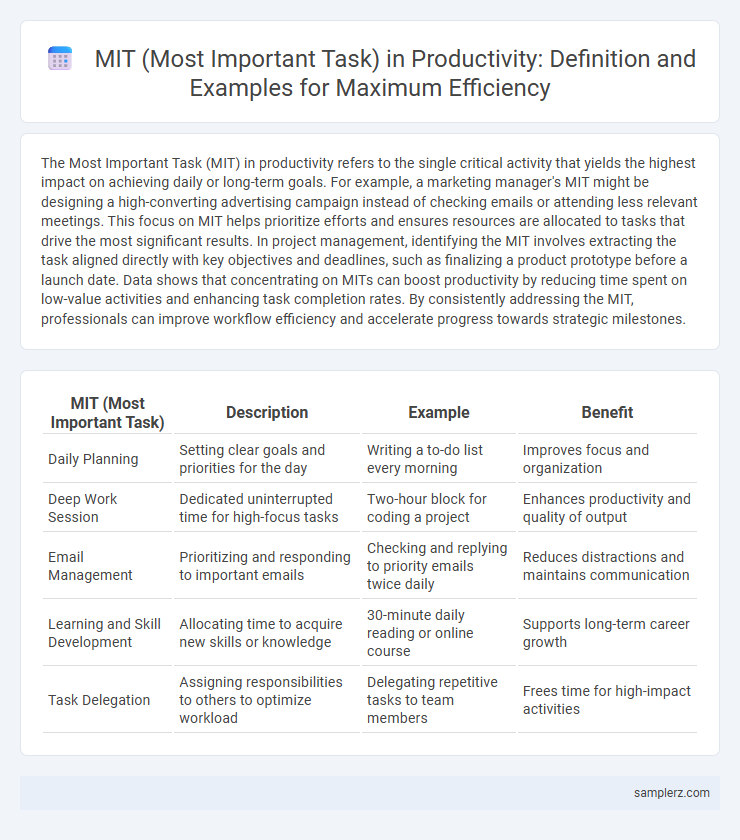The Most Important Task (MIT) in productivity refers to the single critical activity that yields the highest impact on achieving daily or long-term goals. For example, a marketing manager's MIT might be designing a high-converting advertising campaign instead of checking emails or attending less relevant meetings. This focus on MIT helps prioritize efforts and ensures resources are allocated to tasks that drive the most significant results. In project management, identifying the MIT involves extracting the task aligned directly with key objectives and deadlines, such as finalizing a product prototype before a launch date. Data shows that concentrating on MITs can boost productivity by reducing time spent on low-value activities and enhancing task completion rates. By consistently addressing the MIT, professionals can improve workflow efficiency and accelerate progress towards strategic milestones.
Table of Comparison
| MIT (Most Important Task) | Description | Example | Benefit |
|---|---|---|---|
| Daily Planning | Setting clear goals and priorities for the day | Writing a to-do list every morning | Improves focus and organization |
| Deep Work Session | Dedicated uninterrupted time for high-focus tasks | Two-hour block for coding a project | Enhances productivity and quality of output |
| Email Management | Prioritizing and responding to important emails | Checking and replying to priority emails twice daily | Reduces distractions and maintains communication |
| Learning and Skill Development | Allocating time to acquire new skills or knowledge | 30-minute daily reading or online course | Supports long-term career growth |
| Task Delegation | Assigning responsibilities to others to optimize workload | Delegating repetitive tasks to team members | Frees time for high-impact activities |
Defining MIT: What Makes a Task Most Important?
Defining the Most Important Task (MIT) centers on identifying a single task that significantly impacts your goals and productivity. The MIT prioritizes tasks tied directly to key outcomes, ensuring focused effort on high-value activities. This method reduces distractions and enhances efficiency by clarifying which task deserves primary attention each day.
Daily MITs: Setting Your Top Priority Each Morning
Daily MITs (Most Important Tasks) enhance productivity by identifying and prioritizing the single most critical task each morning, ensuring focused effort on what drives the greatest impact. This technique leverages goal-setting strategies to reduce decision fatigue and increase task completion rates. Consistently completing Daily MITs leads to improved time management and sustained progress toward long-term objectives.
MIT Examples for Entrepreneurs
Entrepreneurs prioritize MITs like finalizing investor pitches, setting quarterly revenue goals, and developing key product prototypes to boost productivity. These tasks directly impact business growth and secure critical resources, ensuring focused and effective work days. By concentrating on high-value activities, entrepreneurs eliminate distractions and enhance strategic decision-making.
MIT in Academic Productivity: Student Use Cases
Students improve academic productivity by identifying their Most Important Task (MIT) each day, such as completing a challenging research paper or mastering key concepts for upcoming exams. Prioritizing the MIT helps allocate focused time blocks to high-impact activities, reducing procrastination and enhancing learning retention. This strategy boosts overall performance by ensuring that critical academic goals receive consistent attention amid competing responsibilities.
How to Identify Your MIT in a Corporate Setting
Identify your MIT in a corporate setting by prioritizing tasks that directly impact key business goals, such as increasing revenue, improving customer satisfaction, or meeting critical project deadlines. Evaluate daily responsibilities to isolate actions with the highest value, like preparing reports for executive meetings or resolving major client issues. Use tools like the Eisenhower Matrix to categorize tasks, ensuring your MIT aligns with high-impact objectives that drive organizational success.
MIT for Remote Workers: Staying Focused at Home
Remote workers can enhance productivity by prioritizing their Most Important Task (MIT) each day, ensuring critical projects receive focused attention before distractions arise. Setting a dedicated time block for the MIT helps maintain concentration and reduces the impact of home environment interruptions. Tools like digital calendars and task management apps support remote employees in tracking and completing their MIT efficiently.
Personal Life MITs: Enhancing Work-Life Balance
Personal Life MITs in productivity involve prioritizing key tasks that directly contribute to enhancing work-life balance, such as scheduling dedicated family time, setting boundaries for work hours, and planning regular self-care activities. These focused actions reduce stress and increase overall life satisfaction by ensuring that essential personal goals receive consistent attention. Implementing Personal Life MITs fosters a healthier lifestyle and improves long-term productivity by maintaining emotional and physical well-being.
Prioritizing MITs with Eisenhower Matrix
Prioritizing MITs using the Eisenhower Matrix involves categorizing tasks by urgency and importance to focus on high-impact activities first. For example, an urgent and important MIT like preparing a client proposal is tackled before non-urgent but important tasks such as long-term strategic planning. This method enhances productivity by ensuring critical objectives are addressed promptly, reducing procrastination on vital goals.
Overcoming Procrastination with Daily MITs
Identifying the Most Important Task (MIT) each day anchors productivity by providing clear focus and direction, effectively combating procrastination. Prioritizing one high-impact MIT streamlines decision-making and reduces overwhelm, preventing distractions from less critical activities. Completing daily MITs fosters momentum and builds a habit of consistent progress toward key goals, significantly enhancing overall efficiency.
Turning Long-term Goals into Daily MITs
Breaking down long-term goals into daily Most Important Tasks (MITs) accelerates productivity by creating clear, actionable steps. For example, a long-term goal to write a book can be divided into daily MITs such as drafting 500 words or researching one chapter topic. This approach ensures consistent progress by maintaining focus on high-impact activities aligned with broader objectives.

example of **MIT (Most Important Task)** in **productivity** Infographic
 samplerz.com
samplerz.com